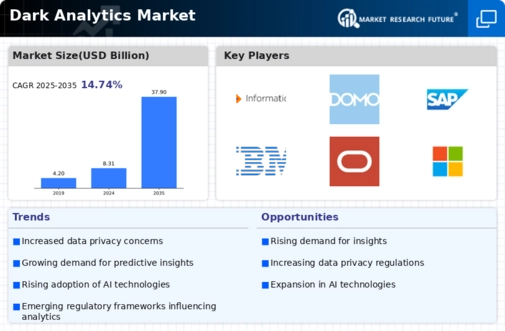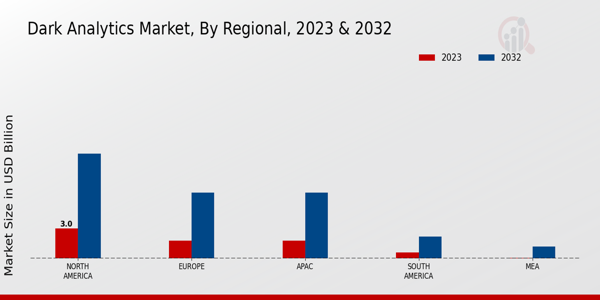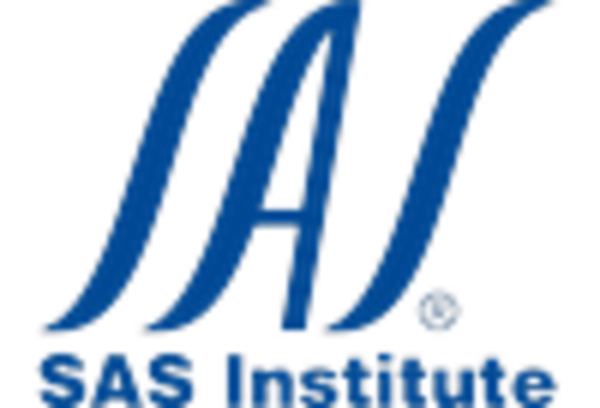Growing Need for Actionable Insights
The Dark Analytics Market is witnessing a rising demand for actionable insights derived from complex data sets. Organizations are increasingly seeking ways to transform dark data into valuable information that can drive strategic decision-making. This trend is underscored by the fact that businesses that leverage analytics effectively are likely to outperform their competitors. Recent studies indicate that companies utilizing advanced analytics are 5 times more likely to make faster decisions than those that do not. Consequently, the market for analytics solutions that can convert dark data into actionable insights is poised for substantial growth. This demand is further fueled by the need for organizations to remain agile and responsive in an ever-evolving business landscape.
Integration of Advanced Technologies
The Dark Analytics Market is experiencing a notable shift towards the integration of advanced technologies such as artificial intelligence and machine learning. These technologies enable organizations to analyze vast amounts of unstructured data, which has traditionally been difficult to interpret. As businesses increasingly recognize the value of harnessing dark data, the demand for sophisticated analytical tools is likely to rise. According to recent estimates, the market for AI-driven analytics solutions is projected to grow at a compound annual growth rate of over 30 percent in the coming years. This trend suggests that companies are prioritizing investments in technologies that can unlock insights from previously untapped data sources, thereby enhancing decision-making processes and operational efficiency.
Emphasis on Data Privacy and Compliance
In the Dark Analytics Market, there is a growing emphasis on data privacy and compliance with regulations such as the General Data Protection Regulation (GDPR) and the California Consumer Privacy Act (CCPA). Organizations are increasingly aware of the potential risks associated with mishandling sensitive data, which has led to a heightened focus on ensuring compliance with legal frameworks. This trend is likely to drive the demand for analytics solutions that not only provide insights but also adhere to stringent data protection standards. As a result, companies are investing in technologies that facilitate secure data handling and processing, thereby fostering trust among consumers and stakeholders. The market for privacy-centric analytics tools is expected to expand significantly, reflecting the industry's commitment to responsible data management.
Emergence of Data-Driven Decision Making
The Dark Analytics Market is witnessing a paradigm shift towards data-driven decision making, as organizations increasingly rely on data to inform their strategies and operations. This trend is indicative of a broader cultural change within businesses, where data is viewed as a critical asset. Companies are now prioritizing the collection and analysis of dark data to gain insights that can enhance their competitive edge. The market for analytics solutions that support data-driven decision making is expected to grow significantly, as organizations seek tools that can provide real-time insights and predictive analytics capabilities. This shift not only reflects the evolving landscape of business intelligence but also underscores the importance of leveraging dark data to drive innovation and growth.
Increased Investment in Data Infrastructure
The Dark Analytics Market is experiencing increased investment in data infrastructure as organizations recognize the importance of robust systems for managing and analyzing dark data. Companies are allocating significant resources to enhance their data storage, processing capabilities, and analytical tools. This trend is driven by the need to support advanced analytics initiatives and ensure that organizations can effectively harness the potential of their dark data. According to industry reports, investments in data infrastructure are expected to reach several billion dollars in the next few years. This influx of capital is likely to facilitate the development of innovative analytics solutions that can address the complexities associated with dark data, ultimately leading to improved business outcomes.


















Leave a Comment